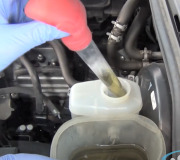You may be making this more complicated than necessary. I have never worked on your model, but the brake system should be similar to those on other models. First of all, did you bench-bleed the new master cylinder before installing it? They usually come with kits that include a pair of short hoses and a pair of plastic fittings for the job. If you did that, the bleeding is ninety percent done. If you did not, you have to push all that pile of air through the system to get it out.
There is a trick I use when removing the old master cylinder that makes bleeding even easier, but we are past that point. Now, when you have the bench-bled master cylinder bolted to the booster, loosen one of the steel line nuts about half a turn, then have a helper push the brake pedal very slowly. It should take about fifteenseconds to push it half-way to the floor. Stop there. In fact, get in the habit of never pushing the brake pedal to the floor as that can damage an older one that has crud and corrosion accumulated at the bottom of its bores. Your helper must holler when they stop moving the pedal, and they must hold it there until you have that line nut tight.
You will see air bubbles spitting out at the line nut while the brake pedal is moving. If the pedal is released before you have that nut tightened, air will be sucked right back in. Do that a second time, and perhaps a third time until you do not see any air bubbles coming out. Do the same thing for the other steel line.
When doing this, the pedal should be pushed very slowly so only brake fluid goes down the lines and any air bubbles have time to float back up. When the pedal is released, it should be done very quickly. The fluid rushing back into the reservoir will wash any sticking air bubbles back up with it.
I have done this for every master cylinder I have replaced, and have not had to bleed at the wheels in years.
If you did not bench-bleed the new master cylinder, there is no point to doing it now as excessive air has already entered the system. If you can look into the reservoir and see one or both ports, you should be able to see air bubbles coming out of them when your helper just starts to push the brake pedal. Air in this case, but normally brake fluid gets pushed out of those ports and flows into the reservoir for about the first inch of pedal travel. After that, as you continue to push the pedal, the rubber lips seals pass those ports, then the brake fluid is trapped and has no choice but to get pushed down to the wheels. What we are interested in is that first inch of travel. Some air got expelled, then when the pedal is released, brake fluid gets sucked in there in its place. If you stroke the pedal that one inch repeatedly, you are bleeding the air out of the master cylinder.
Chances are your car does not have anti-lock brakes, but if it does, there may be two chambers in the hydraulic controller that cannot be bled without a scanner to command the computer to open two valves. We will worry about that later if necessary.
When other parts are replaced and bleeding at a wheel is necessary, the only method I use is gravity-bleeding. This is also the safest way when the car has an old master cylinder that could be damaged by an exuberant, uninformed helper working the brake pedal. Loosen the cap on the reservoir so no vacuum builds up in there that would impede the free flow of fluid. Open any bleeder screws involved in the repair, then take a break and wait for fluid to start running out. If the fluid is dark, that is normal from being hot, but it means it is old fluid. Depending on what was replaced, the air may have not made it down to that wheel yet. Be sure to not let the reservoir run empty. When you see clear fluid coming out of the bleeder screw, it has made it all the way from the master cylinder, and air in that line should be gone. When you are bleeding at multiple wheels, and one has clear fluid coming out, close that bleeder screw, then wait for the next one to flow. If no fluid flows from any wheel within about five minutes or so, "irritate" the brake pedal by hand a little to get the fluid started. Once there is some fluid in the lines, its weight will let gravity pull it down.
Once you have all the bleeder screws tightened and the air is out, work the brake pedal a couple of times. The fluid flowing to the wheels will wash a few sticking air bubbles into the calipers and wheel cylinders. Open each bleeder screw once more for a couple of seconds to let those bubbles pop out, and you are done.
Saturday, July 22nd, 2017 AT 6:40 PM


